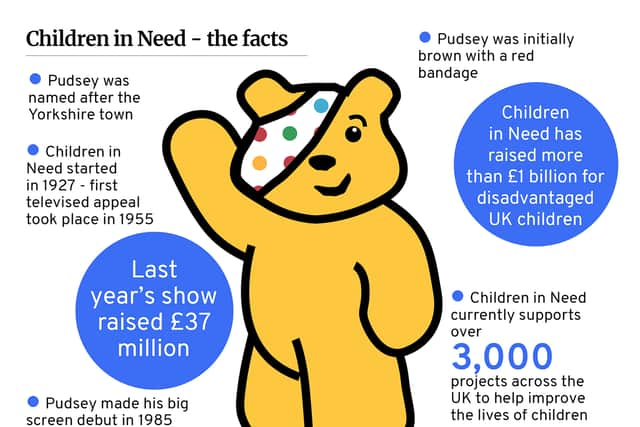How old is Pudsey? Year when Children in Need first started, facts and why the bear became charity’s mascot
This article contains affiliate links. We may earn a small commission on items purchased through this article, but that does not affect our editorial judgement.
and live on Freeview channel 276
As the official mascot of Children in Need, Pudsey Bear is synonymous with the BBC’s long standing UK charity aired on TV.
Regular viewers of the annual charity telethon have become used to seeing Pudsey’s striking yellow fur, colourful spotted eye patch and warm smile.
Advertisement
Hide AdAdvertisement
Hide AdBut when did viewers get a first glimpse of Pudsey, how old is the bear, why does Pudsey wear an eye patch and what are the origins of its name? Let’s find out...
How old is Pudsey?
Despite a youthful appearance, Pudsey is a veteran of the Children in Need scene.
Pudsey made a Children in Need debut more than 30 years ago way back in 1985 and instantly transformed the charity’s brand.
BBC designer Joanna Lane is credited with creating Pudsey and took the name from her home town in Yorkshire, where her grandfather was once mayor.
Advertisement
Hide AdAdvertisement
Hide AdPudsey was initially brown with a red bandage on its head and the buttons down the bear’s front spelled out BBC but this has gradually changed over the years.
Pudsey’s eye patch, or bandage, is widely understood to represent the bear being in need too, to relate to other children who may feel different or alone.
Pudsey will turn 36 at the 2021 Children in Need.


When did Children in Need start?
Children in Need is a long standing BBC charity which first began in 1927.
That inaugural broadcast took the form of a five minute radio broadcast on Christmas Day, with the charity growing over the years.
Advertisement
Hide AdAdvertisement
Hide AdThe first televised appeal took place in 1955 and was called the Children’s Hour Christmas Appeal. It was another 30 years before Pudsey entered.
Children in Need has raised more than £1 billion for disadvantaged kids and young people in the UK over the past 94 years, including just over £37 million last year alone.
Why is Pudsey the mascot of Children in Need?
In a bid to attract more interest in the charity, BBC execs asked its design team to create a new logo to front its Children in Need appeal.
Designer Joanna Lane came up with the idea of a teddy bear and had the honour of deciding its name too, which she explained in a BBC interview.
Advertisement
Hide AdAdvertisement
Hide AdShe said: "It came from the heart. I looked to my own experience and named him in honour of my home town and my grandparents."
Joanna was born in Pudsey, a Yorkshire town in between Bradford and Leeds with a population of around 23,000, and decided to name the bear after her birthplace.
Pudsey was first introduced to audiences by broadcasting great Sir Terry Wogan in 1985 and became the charity’s official logo the following year.
The town has paid homage to Pudsey the bear with a floral representation in Pudsey Park.
Children in Need facts
- Pudsey was named after the Yorkshire town
- Pudsey made his big screen debut in 1985
- Pudsey was initially brown with a red bandage
- Pudsey has a friend called Blush who was first introduced in 2009
- Children in Need started in 1927 - first televised appeal took place in 1955
- Children in Need has raised more than £1 billion for disadvantaged UK children
Advertisement
Hide AdAdvertisement
Hide AdDonations for Children in Need can be made through the charity’s official website.
A message from the editor:
Thank you for reading. NationalWorld is a new national news brand, produced by a team of journalists, editors, video producers and designers who live and work across the UK. Find out more about who’s who in the team, and our editorial values. We want to start a community among our readers, so please follow us on Facebook, Twitter and Instagram, and keep the conversation going. You can also sign up to our email newsletters and get a curated selection of our best reads to your inbox every day.
Comment Guidelines
National World encourages reader discussion on our stories. User feedback, insights and back-and-forth exchanges add a rich layer of context to reporting. Please review our Community Guidelines before commenting.
